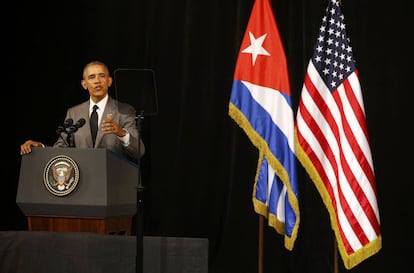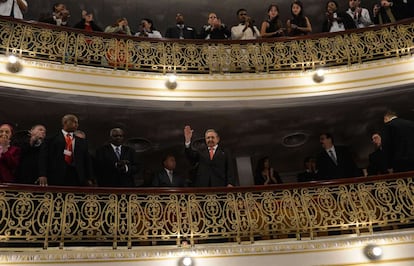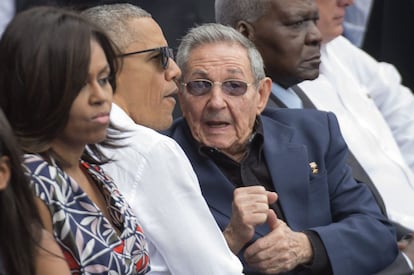Obama defends democracy in Havana speech to Cuban nation
US president and Cuban leader Raúl Castro chat for an hour at a friendly baseball match

Standing before the Cuban government’s top officials, US President Barack Obama on Tuesday defended the advantages of democracy for making the most of Cuba’s enormous potential.
At a speech in Havana’s Grand Theater, the American leader said he did not wish to impose change, but asked Cuban President Raúl Castro not to fear criticism in his own country or his citizens’ ability to choose their own leaders.
“The future of Cuba must be in the hands of the Cubans,” he said in Spanish.
Listening to him inside the gallery reserved for the authorities were Castro and other top Cuban officials. The dancer Alicia Alonso, a Cuban cultural icon, was also among them.
When Obama talked about democracy, the US delegation clapped while most of the hall remained silent
But the US president wanted above all to speak to the Cuban people, who were following the speech on television.
The event offered up one of those small miracles made possible by the thaw in relations between the US and Cuba: the sight of an American president, in the heart of Havana, formulating a reasoned defense of liberal democracy.
He was able to do it because his speech did not come wrapped in a plan to depose the Cuban government or change the regime, as had happened in the past. And to Cuban authorities, his words were a minor problem compared with the benefits of opening up to their powerful neighbor to the north.
“I have come here to bury the last remnant of the Cold War in the Americas,” began Obama. He then listed all the things that bring both nations together: their history of slavery, their passion for baseball and a culture on display in both Havana and in Miami, the US capital of Cuban exiles and immigrants.

Obama explained why, in 2015, he decided to normalize relations with Cuba after more than half a century of confrontation: the isolation policy was not working. He said that he had asked Congress to rescind the trade embargo with Cuba, which is Havana’s main bone of contention with Washington.
It was the third and last day of Obama’s visit to Cuba, the first by a sitting US president in 88 years. The trip has been something of a reality check: the thaw does not constitute a new romance between the US and Cuba. Rather, the distance between both governments is enormous, and even if both leaders kept human rights out of the conversations, the issue was unavoidable.
“Creo en el pueblo cubano [I believe in the Cuban people],” said Obama in Spanish.
Obama’s argument was that commercial, personal and idea exchanges are essential for the full development of Cuba.
The US leader wrapped his message in a modest tone
The US leader wrapped his message in a modest tone: he said he did not wish to impose anything, just to expound his own ideas. Without democracy, the son of a black man from Kenya and a white woman from Kansas would not be US president today, he said. Without a political – and economic – opening up, the opportunities for Cubans will not be fully realized.
The US president did not seek to discredit the revolution, accepted that some Americans exploited Cuba before the 1959 revolt, and mentioned the suspicion raised in Havana by the first exiles in the US – but he also talked about the pain of separation and the hope in a future of reconciliation.
When Obama talked about democracy, the US delegation clapped while most of the hall remained silent.
Addressing Castro specifically, Obama said: “Given your commitment to Cuba’s sovereignty and self-determination, I’m also confident that you need not fear the different voices of the Cuban people and their capacity to speak and assemble and vote for their leaders.”
When the speech ended, hardly anybody in the gallery where the authorities were seated applauded. Raúl Castro briefly clapped, then saluted the crowd that was applauding him.
A little help from baseball
After the lukewarm reception to Obama’s address, and the US president’s meetings with political dissidents, it looked like the historic visit to seal the thaw between both nations was heading for a colder ending than expected.
But that was until baseball stepped in.
The sport that raises passions on both sides of the strait worked its magic, and Obama and Castro were seen chatting enthusiastically for the entire hour that they sat inside the Latinoamericano stadium watching part of the the first game between a Cuban and an American team in 17 years.

What did they talk about? Was it just sports, or was there something more? Could this encounter be counted as a fourth bilateral meeting, this time in the presence of nearly 50,000 fans who had filled the venue to capacity?
The stadium is symbolic in many ways. On November 18, 1999, two other presidents – Fidel Castro and Hugo Chávez – donned their respective teams’ uniforms for a friendly match that symbolized their excellent relations until the Venezuelan leader’s death three years ago. Chávez’s successor, Nicolás Maduro, visited Cuba right before Obama’s visit and had his picture taken with Fidel.
Neither Obama nor Raúl Castro stayed to watch the Tampa Bay Rays beat the national Cuban team 4-1. Perhaps it was better that way, as there was no need to talk about winners and losers at the close of a visit that will be the subject of much discussion for a long time to come.
English version by Susana Urra.
Tu suscripción se está usando en otro dispositivo
¿Quieres añadir otro usuario a tu suscripción?
Si continúas leyendo en este dispositivo, no se podrá leer en el otro.
FlechaTu suscripción se está usando en otro dispositivo y solo puedes acceder a EL PAÍS desde un dispositivo a la vez.
Si quieres compartir tu cuenta, cambia tu suscripción a la modalidad Premium, así podrás añadir otro usuario. Cada uno accederá con su propia cuenta de email, lo que os permitirá personalizar vuestra experiencia en EL PAÍS.
¿Tienes una suscripción de empresa? Accede aquí para contratar más cuentas.
En el caso de no saber quién está usando tu cuenta, te recomendamos cambiar tu contraseña aquí.
Si decides continuar compartiendo tu cuenta, este mensaje se mostrará en tu dispositivo y en el de la otra persona que está usando tu cuenta de forma indefinida, afectando a tu experiencia de lectura. Puedes consultar aquí los términos y condiciones de la suscripción digital.
Archived In
Últimas noticias
Welcome to the post-religion era: The idea of Christianity as the absolute truth has become obsolete
‘I thought you would like it’: The risky sexual practice popularized by TV shows and TikTok
The digitalization of tourism: ‘They promise experiences and gave us the worst possible one’
Mexican peso defies uncertainty with forecasts of a new period of stability in 2026
Most viewed
- Sinaloa Cartel war is taking its toll on Los Chapitos
- Oona Chaplin: ‘I told James Cameron that I was living in a treehouse and starting a permaculture project with a friend’
- Reinhard Genzel, Nobel laureate in physics: ‘One-minute videos will never give you the truth’
- Why the price of coffee has skyrocketed: from Brazilian plantations to specialty coffee houses
- Silver prices are going crazy: This is what’s fueling the rally








































